Pumping Station Desing - Second Edition by Robert L. Sanks, George Tchobahoglous, Garr M. Jones
Подождите немного. Документ загружается.

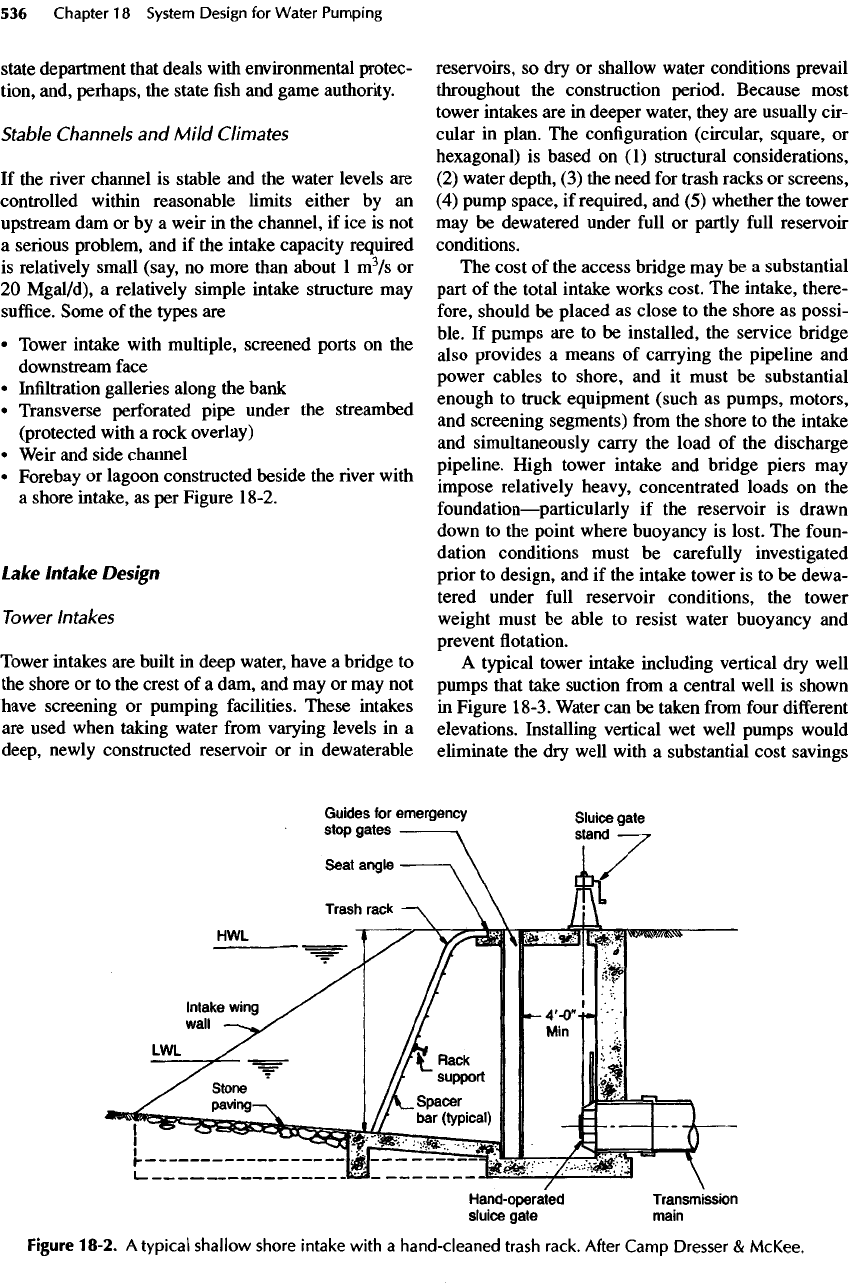
state department that
deals
with environmental
protec-
tion, and, perhaps,
the
state
fish and
game authority.
Stable Channels
and
Mild Climates
If
the river
channel
is
stable
and the
water levels
are
controlled within reasonable limits either
by an
upstream
dam or by a
weir
in the
channel,
if ice is not
a
serious problem,
and if the
intake capacity required
is
relatively small (say,
no
more than about
1
m
3
/s
or
20
Mgal/d),
a
relatively simple intake structure
may
suffice.
Some
of the
types
are
•
Tower intake with multiple, screened ports
on the
downstream
face
•
Infiltration
galleries
along
the
bank
•
Transverse perforated pipe under
the
streambed
(protected with
a
rock overlay)
•
Weir
and
side channel
•
Forebay
or
lagoon constructed beside
the river
with
a
shore intake,
as per
Figure
18-2.
Lake
Intake Design
Tower
Intakes
Tower
intakes
are
built
in
deep water, have
a
bridge
to
the
shore
or to the
crest
of a
dam,
and may or may not
have
screening
or
pumping facilities.
These
intakes
are
used when taking water
from
varying levels
in a
deep, newly constructed reservoir
or in
dewaterable
reservoirs,
so dry or
shallow water conditions prevail
throughout
the
construction period. Because most
tower
intakes
are in
deeper water, they
are
usually cir-
cular
in
plan.
The
configuration (circular, square,
or
hexagonal)
is
based
on (1)
structural considerations,
(2)
water depth,
(3) the
need
for
trash racks
or
screens,
(4)
pump space,
if
required,
and (5)
whether
the
tower
may
be
dewatered under
full
or
partly
full
reservoir
conditions.
The
cost
of the
access bridge
may be a
substantial
part
of the
total intake works cost.
The
intake, there-
fore,
should
be
placed
as
close
to the
shore
as
possi-
ble.
If
pumps
are to be
installed,
the
service bridge
also provides
a
means
of
carrying
the
pipeline
and
power cables
to
shore,
and it
must
be
substantial
enough
to
truck equipment (such
as
pumps, motors,
and
screening segments)
from
the
shore
to the
intake
and
simultaneously carry
the
load
of the
discharge
pipeline. High tower intake
and
bridge piers
may
impose relatively heavy, concentrated loads
on the
foundation
—
particularly
if the
reservoir
is
drawn
down
to the
point where buoyancy
is
lost.
The
foun-
dation conditions must
be
carefully investigated
prior
to
design,
and if the
intake tower
is to be
dewa-
tered under
full
reservoir conditions,
the
tower
weight must
be
able
to
resist water buoyancy
and
prevent
flotation.
A
typical tower intake including vertical
dry
well
pumps
that take suction
from
a
central well
is
shown
in
Figure 18-3. Water
can be
taken
from
four
different
elevations. Installing vertical
wet
well pumps would
eliminate
the dry
well with
a
substantial cost savings
Figure
18-2.
Atypical
shallow
shore
intake
with
a
hand-cleaned
trash
rack.
After
Camp
Dresser
&
McKee.
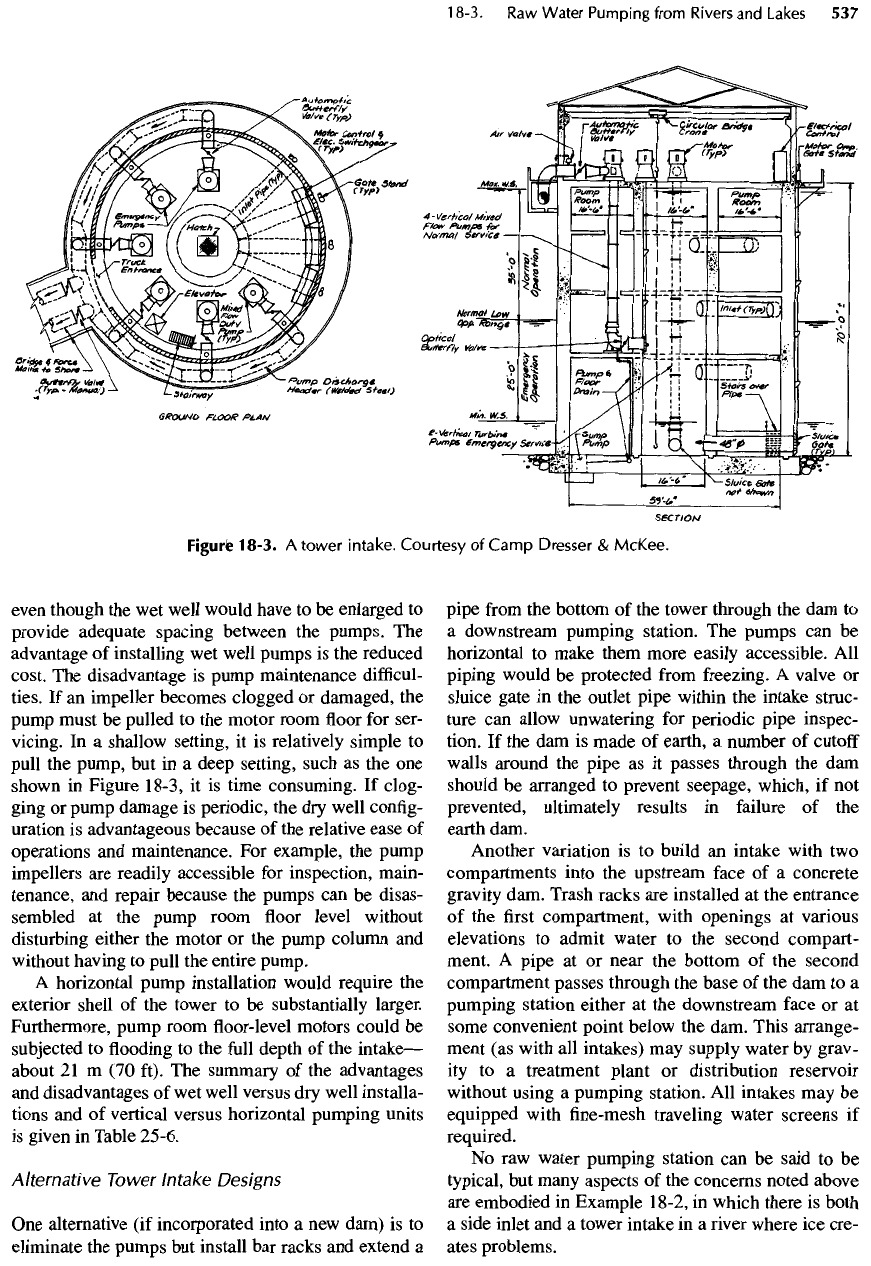
even
though
the wet
well would have
to be
enlarged
to
provide adequate spacing between
the
pumps.
The
advantage
of
installing
wet
well pumps
is the
reduced
cost.
The
disadvantage
is
pump maintenance
difficul-
ties.
If an
impeller becomes clogged
or
damaged,
the
pump
must
be
pulled
to the
motor room
floor for
ser-
vicing.
In a
shallow setting,
it is
relatively simple
to
pull
the
pump,
but in a
deep setting, such
as the one
shown
in
Figure
18-3,
it is
time consuming.
If
clog-
ging
or
pump damage
is
periodic,
the dry
well
config-
uration
is
advantageous because
of the
relative ease
of
operations
and
maintenance.
For
example,
the
pump
impellers
are
readily accessible
for
inspection, main-
tenance,
and
repair because
the
pumps
can be
disas-
sembled
at the
pump room
floor
level without
disturbing
either
the
motor
or the
pump column
and
without
having
to
pull
the
entire pump.
A
horizontal pump
installation
would require
the
exterior shell
of the
tower
to be
substantially larger.
Furthermore, pump room
floor-level
motors could
be
subjected
to flooding to the
full
depth
of the
intake
—
about
21 m (70
ft).
The
summary
of the
advantages
and
disadvantages
of wet
well versus
dry
well installa-
tions
and of
vertical versus horizontal pumping units
is
given
in
Table 25-6.
Alternative
Tower Intake Designs
One
alternative
(if
incorporated into
a new
dam)
is to
eliminate
the
pumps
but
install
bar
racks
and
extend
a
pipe
from
the
bottom
of the
tower through
the dam to
a
downstream pumping
station.
The
pumps
can be
horizontal
to
make them more easily accessible.
All
piping would
be
protected
from
freezing.
A
valve
or
sluice gate
in the
outlet
pipe
within
the
intake struc-
ture
can
allow
unwatering
for
periodic pipe inspec-
tion.
If the dam is
made
of
earth,
a
number
of
cutoff
walls around
the
pipe
as it
passes
through
the dam
should
be
arranged
to
prevent seepage, which,
if not
prevented, ultimately results
in
failure
of the
earth dam.
Another variation
is to
build
an
intake with
two
compartments into
the
upstream
face
of a
concrete
gravity
dam. Trash
racks
are
installed
at the
entrance
of
the first
compartment, with openings
at
various
elevations
to
admit water
to the
second compart-
ment.
A
pipe
at or
near
the
bottom
of the
second
compartment passes through
the
base
of the dam to a
pumping
station either
at the
downstream
face
or at
some convenient point below
the
dam.
This
arrange-
ment
(as
with
all
intakes)
may
supply water
by
grav-
ity
to a
treatment plant
or
distribution reservoir
without using
a
pumping
station.
All
intakes
may be
equipped with
fine-mesh
traveling water screens
if
required.
No
raw
water pumping station
can be
said
to be
typical,
but
many aspects
of the
concerns noted above
are
embodied
in
Example
18-2,
in
which there
is
both
a
side inlet
and a
tower intake
in a
river where
ice
cre-
ates problems.
Figurfe
18-3.
A
tower intake. Courtesy
of
Camp
Dresser
&
McKee.
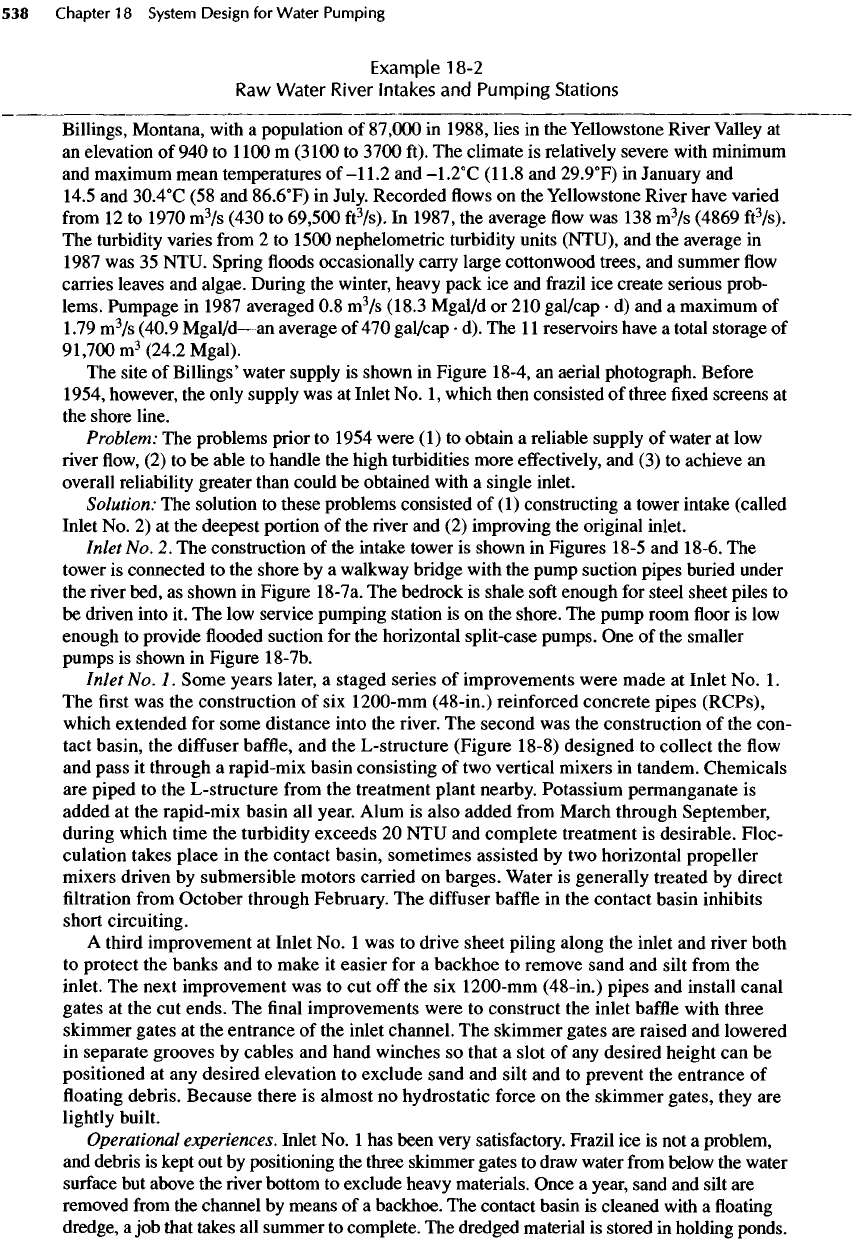
Example
18-2
Raw
Water
River
Intakes
and
Pumping
Stations
Billings, Montana, with
a
population
of
87,000
in
1988,
lies
in the
Yellowstone River Valley
at
an
elevation
of 940 to
1100
m
(3100
to
3700
ft).
The
climate
is
relatively severe with minimum
and
maximum mean temperatures
of-11.2
and
-1.2
0
C
(11.8
and
29.9
0
F)
in
January
and
14.5
and
30.4
0
C
(58 and
86.6
0
F)
in
July. Recorded
flows on the
Yellowstone River have varied
from
12 to
1970
m
3
/s
(430
to
69,500
ft
3
/s).
In
1987,
the
average
flow was 138
m
3
/s
(4869
ft
3
/s).
The
turbidity varies
from
2 to
1500
nephelometric
turbidity units (NTU),
and the
average
in
1987
was 35
NTU. Spring
floods
occasionally carry large cottonwood
trees,
and
summer
flow
carries leaves
and
algae. During
the
winter, heavy pack
ice and
frazil
ice
create serious prob-
lems.
Pumpage
in
1987 averaged
0.8
m
3
/s
(18.3
Mgal/d
or 210
gal/cap
• d) and a
maximum
of
1.79
m
3
/s
(40.9
Mgal/d—
an
average
of 470
gal/cap
• d). The
11
reservoirs have
a
total storage
of
91,700m
3
(24.2
Mgal).
The
site
of
Billings' water supply
is
shown
in
Figure
18-4,
an
aerial photograph. Before
1954,
however,
the
only supply
was at
Inlet
No. 1,
which then consisted
of
three
fixed
screens
at
the
shore line.
Problem:
The
problems prior
to
1954
were
(1)
to
obtain
a
reliable supply
of
water
at low
river
flow, (2) to be
able
to
handle
the
high turbidities more
effectively,
and (3) to
achieve
an
overall reliability greater than could
be
obtained with
a
single inlet.
Solution:
The
solution
to
these problems consisted
of
(1)
constructing
a
tower intake (called
Inlet
No. 2) at the
deepest portion
of the river and (2)
improving
the
original inlet.
Inlet
No. 2. The
construction
of the
intake tower
is
shown
in
Figures 18-5
and
18-6.
The
tower
is
connected
to the
shore
by a
walkway
bridge with
the
pump suction pipes buried under
the river
bed,
as
shown
in
Figure
18-7a.
The
bedrock
is
shale
soft
enough
for
steel sheet piles
to
be
driven into
it. The low
service pumping station
is on the
shore.
The
pump room
floor is low
enough
to
provide
flooded
suction
for the
horizontal split-case pumps.
One of the
smaller
pumps
is
shown
in
Figure
18-7b.
Inlet
No.
1.
Some years later,
a
staged series
of
improvements were made
at
Inlet
No.
1.
The first was the
construction
of six
1200-mm
(48-in.) reinforced concrete pipes (RCPs),
which
extended
for
some distance into
the
river.
The
second
was the
construction
of the
con-
tact
basin,
the
diffuser
baffle,
and the
L-structure
(Figure
18-8)
designed
to
collect
the flow
and
pass
it
through
a
rapid-mix basin consisting
of two
vertical mixers
in
tandem. Chemicals
are
piped
to the
L-structure
from
the
treatment plant nearby. Potassium permanganate
is
added
at the
rapid-mix basin
all
year. Alum
is
also added
from
March through September,
during
which time
the
turbidity exceeds
20 NTU and
complete treatment
is
desirable.
Floc-
culation takes
place
in the
contact
basin, sometimes
assisted
by two
horizontal
propeller
mixers
driven
by
submersible motors carried
on
barges. Water
is
generally treated
by
direct
filtration
from
October through February.
The
diffuser
baffle
in the
contact basin inhibits
short circuiting.
A
third improvement
at
Inlet
No. 1 was to
drive sheet piling along
the
inlet
and
river both
to
protect
the
banks
and to
make
it
easier
for a
backhoe
to
remove sand
and
silt
from
the
inlet.
The
next improvement
was to cut off the six
1200-mm
(48-in.) pipes
and
install canal
gates
at the cut
ends.
The final
improvements were
to
construct
the
inlet
baffle
with three
skimmer
gates
at the
entrance
of the
inlet
channel.
The
skimmer gates
are
raised
and
lowered
in
separate grooves
by
cables
and
hand winches
so
that
a
slot
of any
desired height
can be
positioned
at any
desired elevation
to
exclude sand
and
silt
and to
prevent
the
entrance
of
floating
debris. Because there
is
almost
no
hydrostatic force
on the
skimmer gates, they
are
lightly
built.
Operational
experiences.
Inlet
No. 1 has
been very satisfactory. Frazil
ice is not a
problem,
and
debris
is
kept
out by
positioning
the
three skimmer gates
to
draw water
from
below
the
water
surface
but
above
the river
bottom
to
exclude heavy materials. Once
a
year, sand
and
silt
are
removed
from
the
channel
by
means
of a
backhoe.
The
contact basin
is
cleaned with
a floating
dredge,
a job
that takes
all
summer
to
complete.
The
dredged material
is
stored
in
holding ponds.
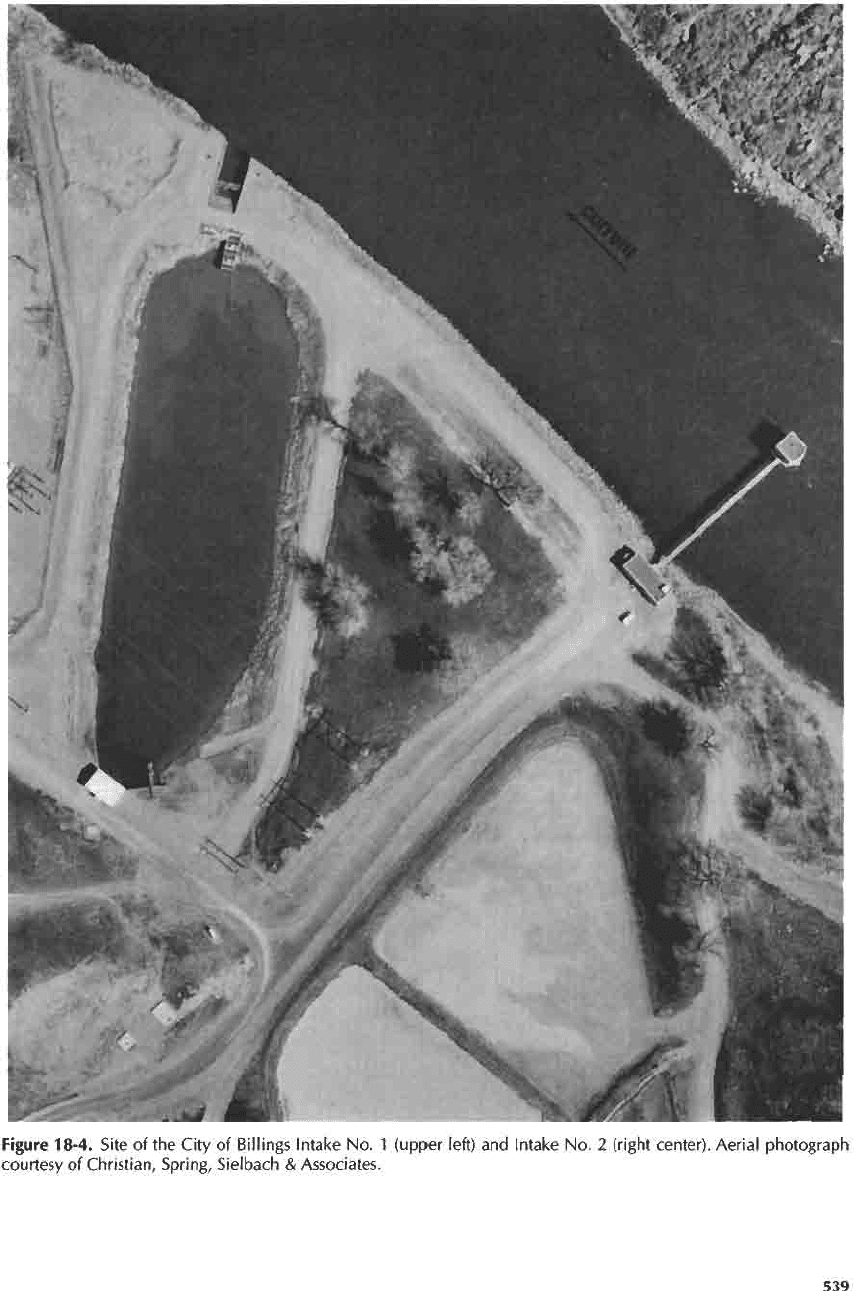
Figure
18-4.
Site
of the
City
of
Billings Intake
No. 1
(upper left)
and
Intake
No. 2
(right center). Aerial
photograph
courtesy
of
Christian,
Spring,
Sielbach
&
Associates.

Figure
18-5. Tower
intake,
Inlet
No. 2. (a)
Floor
plan;
(b)
Section
B-B
from Figure 18-6.

Figure 18-6. Section
A-A
from
Figure 18-5.
Inlet
No. 1 is
used most
of the
time, partly because
it is
trouble
free,
but—more
important—
because
it
contains
the
L-structure,
which
is
used
as
part
of the
treatment
process.
Inlet
No. 2.
Inlet
No. 2 is
used
for
emergency
service
when
Inlet
No. 1 is
closed
for
repairs;
it
is
also used during
periods
of
very
low flow
when
the
water
can be
treated
by
direct
filtration.
Frazil
ice
causes serious problems
at
times. Because
it
clogs
the
steel screens, which must
be
cleaned
by
hand
(an
onerous task), Inlet
No. 1 is
used
(if
possible) whenever
frazil
ice is
forming.
Pack
ice
causes
ice
jams and,
at
times,
a
pileup
of ice at
both
the
intake tower
and the
walk-
way.
Ice
jams have formed downstream,
and
they have caused
the
water level
to
rise
11
ft in 25
min. Water has,
at
times,
flowed
over
the
bridge. Large cottonwood
trees
are
sometimes caught
either
on the
intermediate piers
or on the
walkway
and can
damage railings.
To
remove
the
trees,
a
cable must
be
attached
and
they must
be
winched upstream where
the
branches
can be
sawed
off.
Workers
are
reminded
of the
hazards
of
this duty
by the
shuddering
of the
bridge
in
such cir-
cumstances.
A
section
of the
bridge
was
once carried away.
The
walkway
and one
intermediate
pier have since been repaired,
and the
nose
of the
intake tower
has
been sheathed with
12-mm
(1/2-in.)
steel
plate.
Object
lessons
for
designers. Designers
of river
works would
do
well
to be
guided
by
thoughtful
contemplation
of the
three decades
of
operating experiences described above. Some
conclusions
are as
follows:
•
Side inlets
are
generally satisfactory
if the
problem
of low
water
can be
circumvented. Per-
haps training dykes
or a low
weir would help
to
supply water during
low flows.
• Any
inlet
may
have
to be
closed
for
repairs. Either design
so
that
an
inlet
can be
partially
closed
or
provide
for an
alternate emergency inlet.
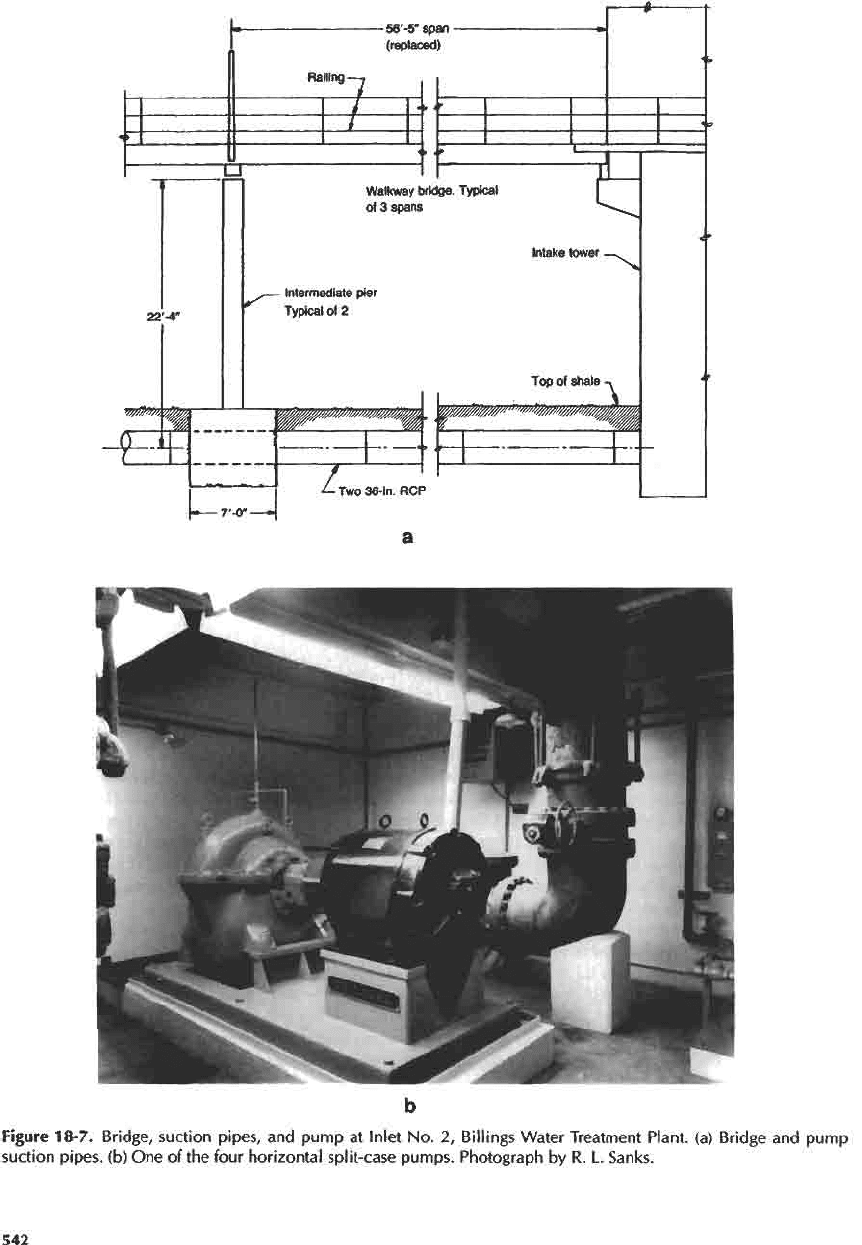
Figure
18-7.
Bridge,
suction pipes,
and
pump
at
Inlet
No. 2,
Billings Water Treatment
Plant,
(a)
Bridge
and
pump
suction
pipes,
(b) One of the
four horizontal split-case pumps. Photograph
by R. L.
Sanks.
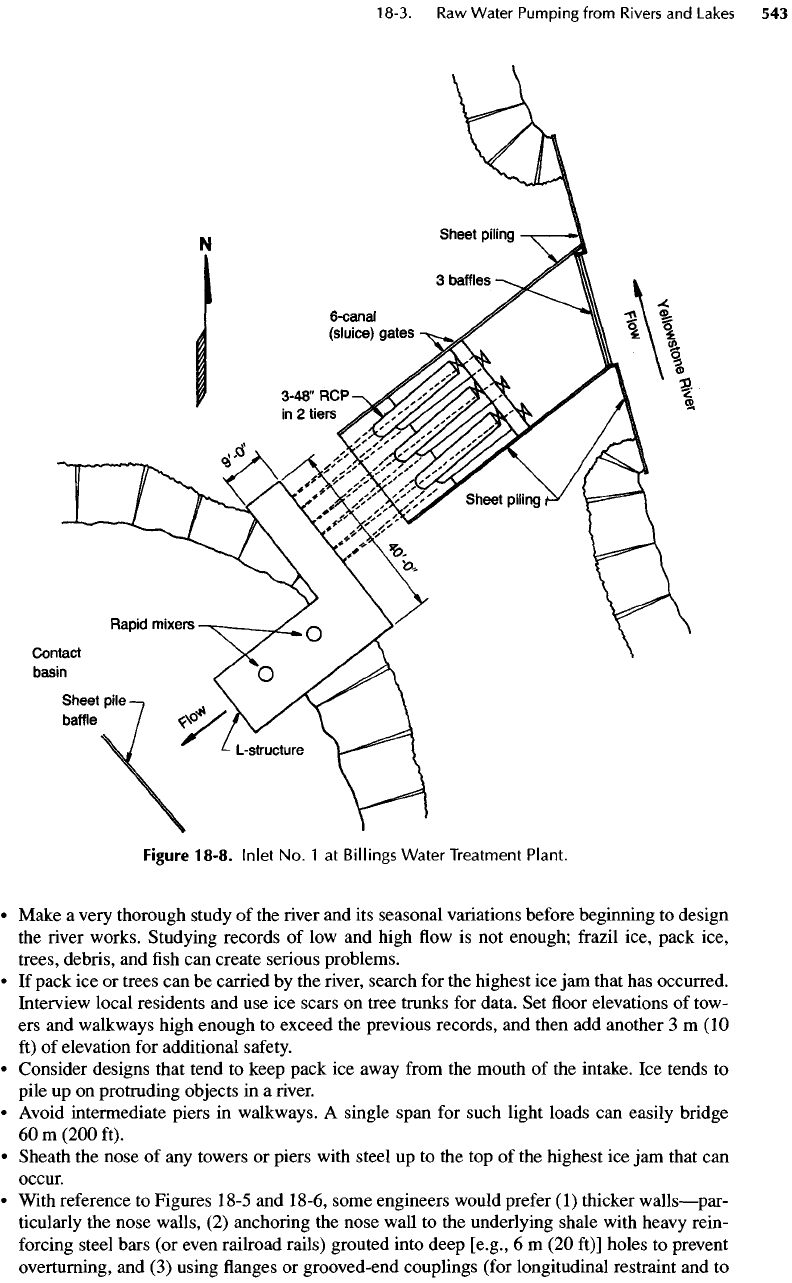
Figure
18-8.
Inlet
No. 1 at
Billings
Water
Treatment Plant.
•
Make
a
very thorough study
of the
river
and its
seasonal variations before beginning
to
design
the
river works. Studying records
of low and
high
flow
is not
enough;
frazil
ice, pack ice,
trees, debris,
and fish can
create serious problems.
• If
pack
ice or
trees
can be
carried
by the
river, search
for the
highest
ice jam
that
has
occurred.
Interview
local residents
and use ice
scars
on
tree trunks
for
data.
Set floor
elevations
of
tow-
ers and
walkways high enough
to
exceed
the
previous records,
and
then
add
another
3 m (10
ft)
of
elevation
for
additional safety.
•
Consider designs that tend
to
keep pack
ice
away
from
the
mouth
of the
intake.
Ice
tends
to
pile
up on
protruding objects
in a
river.
•
Avoid intermediate piers
in
walkways.
A
single span
for
such light loads
can
easily bridge
60 m
(200
ft).
•
Sheath
the
nose
of any
towers
or
piers with steel
up to the top of the
highest
ice jam
that
can
occur.
•
With reference
to
Figures
18-5
and
18-6,
some engineers
would
prefer
(1)
thicker
walls—par-
ticularly
the
nose walls,
(2)
anchoring
the
nose wall
to the
underlying shale with heavy rein-
forcing
steel bars
(or
even railroad rails) grouted into deep [e.g.,
6 m (20
ft)]
holes
to
prevent
overturning,
and (3)
using
flanges or
grooved-end couplings (for longitudinal restraint
and to
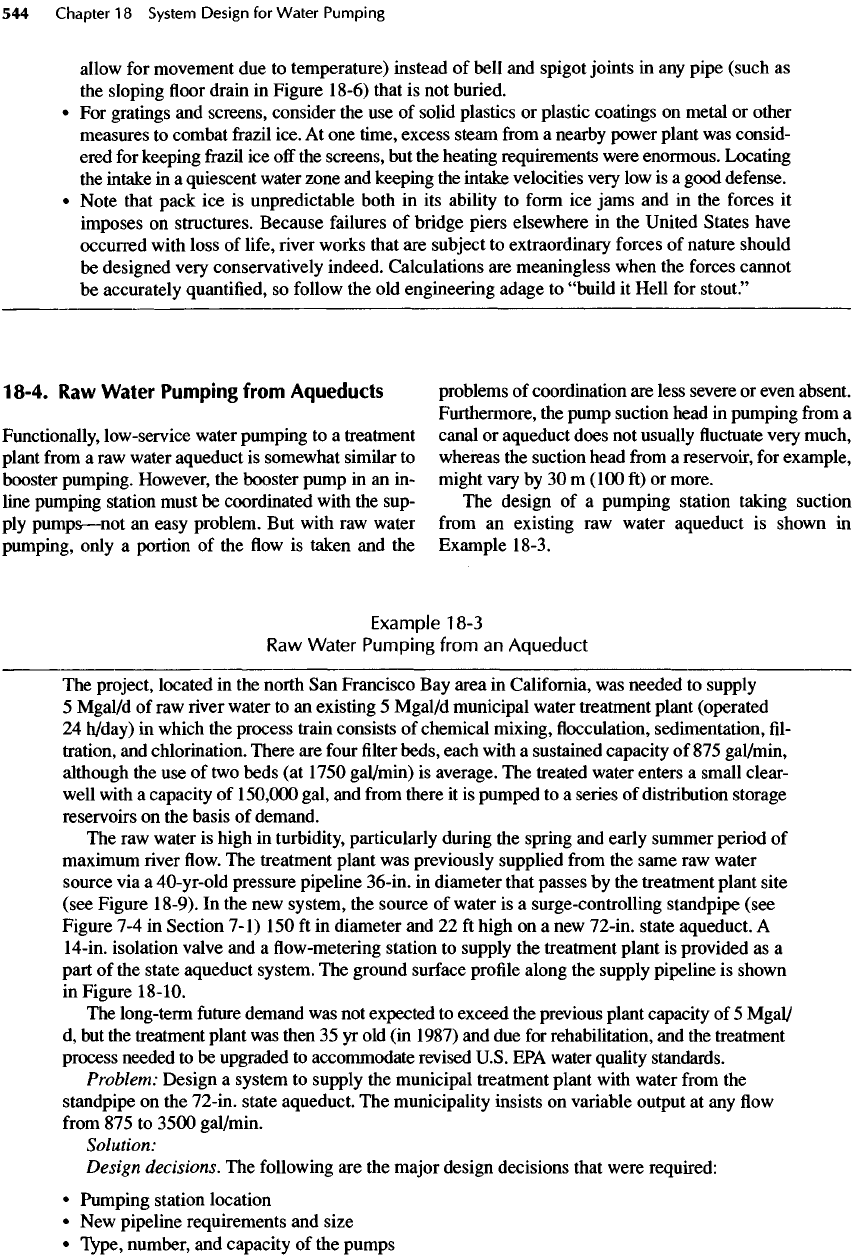
1
8-4.
Raw
Water
Pumping from
Aqueducts
Functionally,
low-service water pumping
to a
treatment
plant
from
a raw
water aqueduct
is
somewhat similar
to
booster pumping. However,
the
booster
pump
in an in-
line pumping station must
be
coordinated with
the
sup-
ply
pumps
—
not
an
easy problem.
But
with
raw
water
pumping,
only
a
portion
of the flow is
taken
and the
problems
of
coordination
are
less severe
or
even absent.
Furthermore,
the
pump suction head
in
pumping
from
a
canal
or
aqueduct does
not
usually
fluctuate
very much,
whereas
the
suction head
from
a
reservoir,
for
example,
might
vary
by 30 m
(100
ft) or
more.
The
design
of a
pumping station taking suction
from
an
existing
raw
water aqueduct
is
shown
in
Example
18-3.
allow
for
movement
due to
temperature) instead
of
bell
and
spigot joints
in any
pipe (such
as
the
sloping
floor
drain
in
Figure
18-6)
that
is not
buried.
• For
gratings
and
screens, consider
the use of
solid
plastics
or
plastic coatings
on
metal
or
other
measures
to
combat
frazil
ice.
At one
time, excess steam
from
a
nearby power plant
was
consid-
ered
for
keeping
frazil
ice
off
the
screens,
but the
heating requirements were enormous. Locating
the
intake
in a
quiescent water zone
and
keeping
the
intake velocities very
low is a
good defense.
•
Note that pack
ice is
unpredictable both
in its
ability
to
form
ice
jams
and in the
forces
it
imposes
on
structures. Because
failures
of
bridge piers elsewhere
in the
United States have
occurred
with loss
of
life,
river works that
are
subject
to
extraordinary forces
of
nature should
be
designed very conservatively
indeed.
Calculations
are
meaningless when
the
forces cannot
be
accurately
quantified,
so
follow
the old
engineering adage
to
"build
it
Hell
for
stout."
Example
18-3
Raw
Water
Pumping
from
an
Aqueduct
The
project, located
in the
north
San
Francisco
Bay
area
in
California,
was
needed
to
supply
5
Mgal/d
of raw river
water
to an
existing
5
Mgal/d
municipal water treatment plant (operated
24
h/day)
in
which
the
process train
consists
of
chemical mixing,
flocculation,
sedimentation, fil-
tration,
and
chlorination.
There
are
four
filter
beds, each with
a
sustained capacity
of 875
gal/min,
although
the use of two
beds
(at
1750
gal/min)
is
average.
The
treated water enters
a
small clear-
well
with
a
capacity
of
150,000
gal,
and
from
there
it is
pumped
to a
series
of
distribution storage
reservoirs
on the
basis
of
demand.
The raw
water
is
high
in
turbidity, particularly during
the
spring
and
early summer
period
of
maximum
river flow. The
treatment plant
was
previously supplied
from
the
same
raw
water
source
via a
40-yr-old
pressure
pipeline
36-in.
in
diameter that passes
by the
treatment plant site
(see Figure
18-9).
In the new
system,
the
source
of
water
is a
surge-controlling standpipe (see
Figure
7-4 in
Section
7-1)
150
ft in
diameter
and 22 ft
high
on a new
72-in. state aqueduct.
A
14-in.
isolation valve
and a flow-metering
station
to
supply
the
treatment plant
is
provided
as a
part
of the
state aqueduct system.
The
ground surface
profile
along
the
supply pipeline
is
shown
in
Figure
18-10.
The
long-term
future
demand
was not
expected
to
exceed
the
previous plant capacity
of 5
Mgal/
d,
but the
treatment plant
was
then
35
yr
old (in
1987)
and due for
rehabilitation,
and the
treatment
process needed
to be
upgraded
to
accommodate revised U.S.
EPA
water quality standards.
Problem:
Design
a
system
to
supply
the
municipal treatment plant with water
from
the
standpipe
on the
72-in. state aqueduct.
The
municipality
insists
on
variable output
at any flow
from
875 to
3500
gal/min.
Solution:
Design
decisions.
The
following
are the
major
design decisions that were required:
•
Pumping station location
• New
pipeline requirements
and
size
•
Type, number,
and
capacity
of the
pumps
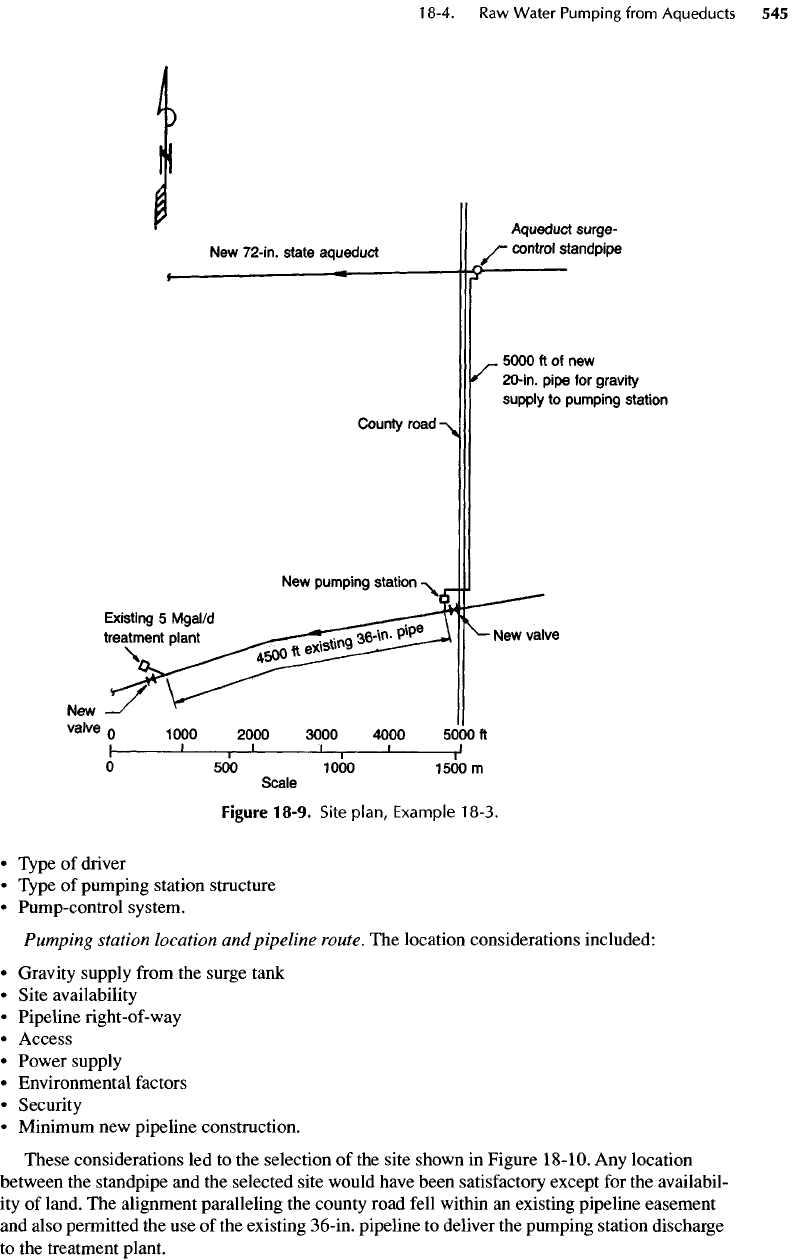
Figure
18-9.
Site
plan,
Example
18-3.
•
Type
of
driver
•
Type
of
pumping station structure
•
Pump-control system.
Pumping
station location
and
pipeline route.
The
location considerations included:
•
Gravity supply
from
the
surge tank
•
Site availability
•
Pipeline
right-of-way
•
Access
•
Power supply
•
Environmental factors
•
Security
•
Minimum
new
pipeline construction.
These considerations
led to the
selection
of the
site shown
in
Figure
18-10.
Any
location
between
the
standpipe
and the
selected site would have been satisfactory except
for the
availabil-
ity
of
land.
The
alignment paralleling
the
county road
fell
within
an
existing pipeline easement
and
also permitted
the use of the
existing
36-in.
pipeline
to
deliver
the
pumping station discharge
to the
treatment plant.
